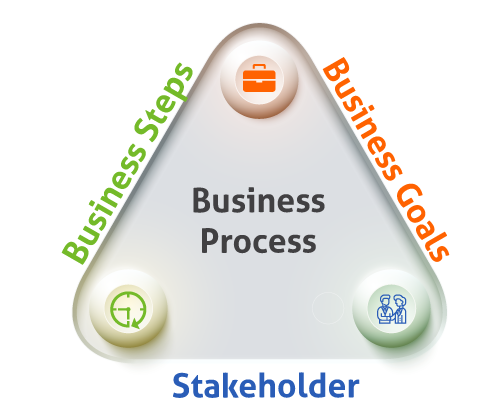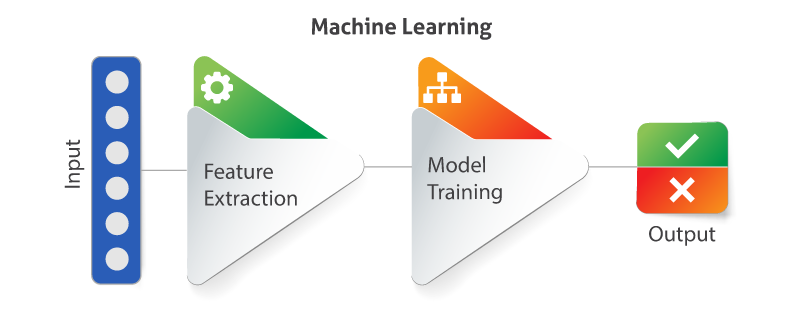A business process is a set of tasks which accomplish a specific organizational goal. These sets of activities and tasks, once completed, will deliver a service or product to the client. The process involves clearly defined inputs and a single output. These inputs are made up of factors that contribute to the added value of an output, i.e., Service or Product.

Robotics Process Automation
Robotic Process Automation (RPA) automates the process with the intent of reducing human efforts in performing repetitive tasks. RPA is outshining traditional automation due to its functionality, accuracy, efficiency, and robustness in the optimization of the business process. By automating the repetitive tasks, employees can engage in a more productive work than doing a job that requires lesser human efforts and innovation.
Here are few use cases of RPA’s capability:
- Integration of data from various sources.
- While sending data to multiple users or applications.
- Rule-based or repetitive task-based policy.
- When the process is simple, but lengthy to perform.
- When the process is complicated, but shorter in length and prone to human error.
Robotic Process Automation is a structured automation process. Any business process can be automated, provided a flowchart or steps of the process. RPA provides platform independent automation solutions, irrespective of desktop or web applications.
There are multiple tools for RPA implementation like:
- UiPath
- Blue Prism
- Automation Anywhere
- Soft Motive
- Pega
- Work Fusion
- NICE
However, UiPath, Automation Anywhere and Blue Prism are the most popular and widely used automation tools. Blue Prism is a desktop-based tool. It is good in automating back-end applications, whereas UiPath is a robust tool with a lot of inbuilt capabilities.
In terms of flexibility, UiPath is more beneficial, but Blue Prism provides better security while automating processes. Most of the RPA tools are based on .Net architecture. In Blue Prism, we can use C#, J#, and Visual Basic; while in UiPath, we only use Visual Basic.
UiPath consists of three major components:
- Studio: It is an advanced tool that helps to design and develop automation processes based on business requirements.
- Robot: It is used to execute the process built in the studio in user-defined machines.
- Orchestration: The orchestrator is used to deploy and schedule the bots according to business requirements.
In simple terms, RPA automates the process using pseudocode, flowchart and sequence. We are not concerned about the code the tool generates at its back-end. However, to gain expertise in RPA, it is good to know about the following topics:
- HTML
- Web Services
- Data Formats
- Database
- OOPs
RPA is capable of executing tasks, but cannot make decisions, unlike the humans. To make intelligent decisions, we require a brain. This is where Artificial Intelligence comes into the picture. With Machine Learning and Deep Learning, we can create intelligent bots that can mimic the human mind and the behavior—capable of taking decisions on your behalf.
Machine Learning
Machine Learning is a set of algorithms that can read data, learn from it and apply based on the learning to make intelligent decisions.

Most machine learning methods are often categorized as supervised learning or unsupervised learning. There are two more categories: Semi-supervised and Reinforcement learning.
- Supervised learning algorithms work with labeled data and can be used to predict future events based on that data. During training, the machine learning algorithm produces an inferred function to make predictions about the target value. After training, the system is capable to provide targets for any new input.
- Unsupervised learning algorithms are used when the information used to train is not labeled. It infers a function to describe a hidden structure from unlabeled data. The algorithm does not figure out the correct output, but it explores the data and can draw inferences from datasets to describe hidden structures from unlabeled data.
Cognitive Services
Cognitive Services are a purpose-built collection of AI algorithms and application programming interfaces (APIs) to help developers add AI capabilities to websites, apps, and AI agents.
Cognitive Services allow enterprises, lacking the necessary AI research staff, infrastructure and budget, to select AI tools for their needs.
Companies that provide cognitive services are:
- Microsoft
- IBM
- Amazon
- Stanford
Python and RPA (UiPath)
With the growing market for RPA, every RPA company wanted to develop an intelligent solution for their customers and to do so, they had to design the brain of the bot. As an obvious choice for the integration, companies decided to go with Python—an open source programming language that supports multiple machine learning and deep learning libraries.
UiPath is one of the leading RPA tools to provide easy integration with Python. Integration is straight forward given that we follow some simple standards during our Python code and UiPath bot integration.
Note: As of now UiPath (v2018.2.3) support Python 3.x < 3.7 (32-bit).
Python
- For easy installation of Python use Anaconda 32-bit version.
- While writing code, use the absolute path of the file in Python code or pass the path as a parameter from UiPath.
- Only use double quotes " in Python code.
- Use a global variable to use the same variables in multiple functions.
- Use json (with all value in ") module to return multiple values.
# import libraries
import math
import json
# define init function
def init(filepath=None)
global path, sum
if(filepath != None):
path = filepath
else:
path = "./"
# define run function
def run(argumnetA, argumentB):
sum = math.pow(argumentA, argumentB)
with open(path+"database.txt") as file:
json.dump(sum, file)
return(json.dumps(sum))
if __name__ == "__main__":
init()
run(2,3)
UiPath
- To integrate, use the root path of Python/Conda installation folder.
- Activities supported by UiPath:
- Python Scope - A container which provides scope for Python activities.
- Invoke Python Method - Helps you run a specified method from a Python script directly in a workflow.
- Run Python Script - Enables you to execute Python code. You can input the code directly in the activity or provide a file path for it.
- Load Python Object - Converts your Python code to a PythonObject variable.
- Get Python Object - Retrieves the value inside a Python object as a .NET type to be used in a workflow.
- Logic from an external Python script can be used using the Invoke Python Method activity.
- Convert Invoke Python Method return object into string before deserializing json.




